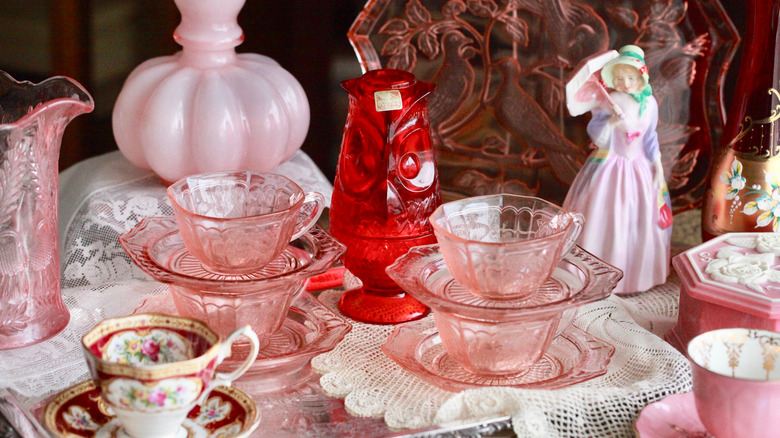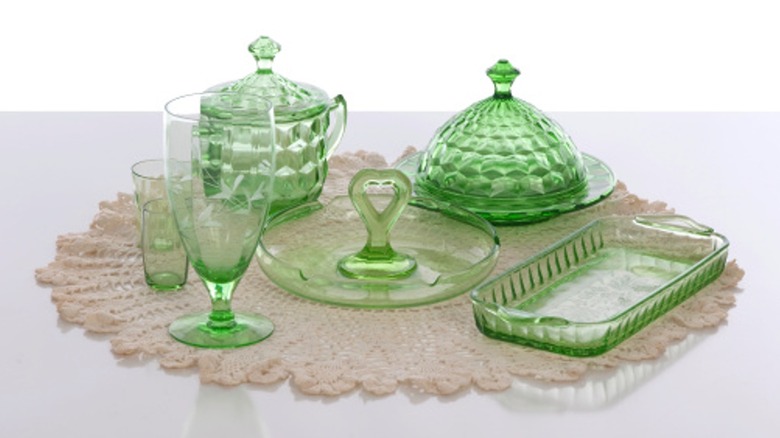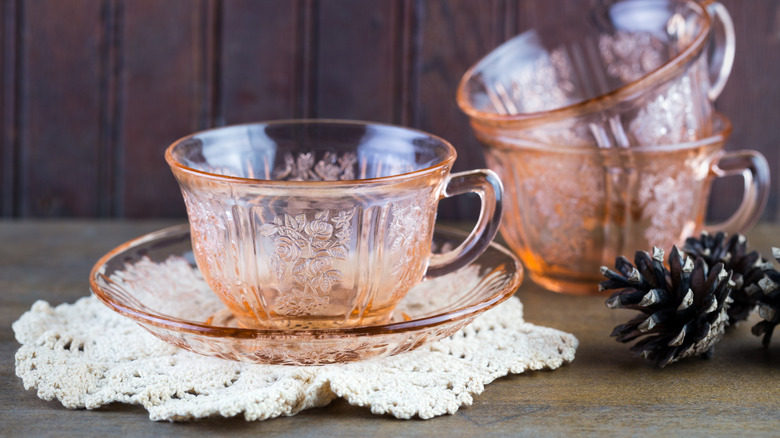How To Spot Authentic Depression Glass When Shopping At Estate Sales
Depression glass, which emerged in the economic free fall of the stock market crash in 1929, has a long and storied history. You will know it by its delightful, colorful range of shades and beautiful patterning which have been cropping up in kitchens and dining rooms since the 1930s. You can often spot them in estate sales, thrifts, and flea markets, in individual or sets, in a range of colors from pale pinks and greens to intense reds and cobalt blues. While not all varieties of colorful glass are Depression glass, colored glass is making a strong comeback with more colorful interior trends like maximalism and grandmillennial style. So how do you determine if what you've found is a genuine article? According to experts, looking for imperfections may be the key to sorting the real from the artificial.
Depression glass was originally an inexpensive alternative to finer crystal, which dominated glassmaking in the first two decades of the 20th century. Exquisite glassware, once the domain of the wealthy, had already become increasingly more accessible to the middle class. After the economic downturn, numerous manufacturers like the Federal Glass Company, Anchor-Hocking Glassware, and the Jeanette Glass Company, sought a way to make inexpensive, but beautiful, glass available to everyone. The result was a molded industrial glass that could not only be purchased in stores but was frequently a giveaway in grocery stores, movie theaters, and gas stations. You could even get pieces in boxes of oatmeal, soap, and laundry detergent.
Telltale imperfections
This industrial process, versus hand-blowing and hand-cutting by craftspeople and artists, is what makes Depression glass from the era easier to spot among fakes. Because the glass was made in molds in a mass-produced process, the spots where the molds came together often created rough seams during the manufacturing process. Other imperfections, like dips and divots, could also occur during the process, as could bubbles on the surface of the glass that make the manufacturing process easy to spot. Air would get trapped in the glass and was unable to escape before cooling.
One great trick for identifying depression class is silhouetting, which entails tracing a piece of paper around the piece and seeing how uniform the sides are, including sips, ridges, and other divots that might entail a machine-making process processing thousands of units a day would create. You can also look carefully at where the pieces come together to make a single piece, looking for ridges or flaws. Pieces created in the past few decades and sold in popular retailers like Target may look like Depression glass but will be smoother and less flawed due to advances in the manufacturing process and greater quality control.
Other ways to spot the real thing
With more research and knowledge, you can also become versed in the common patterns and colors of Depression glass, including the frequency of rarer, and therefore more valuable, varieties like pink and cobalt blue glass, which can be higher in value. While many pieces of Depression glass bear marks on the underside of popular manufacturers during the 1930s and early 1940s, many do not. Many collectors rely on charting patterns, color, and type of piece for more thorough identification. Popular patterns included diamond cuts, art deco patterns, and botanicals. Colors include pink, blue, and green shades, as well as amber, amethyst, white, red, and clear.
You can also learn to spot other kinds of glass that are typically mistaken for Depression glass, including milk glass and carnival glass, which while also beautiful and hailing from the early to mid part of the 20th century, were manufactured differently. Some pieces of genuine depression glass have a similar look to both the creamy white milk glass and the iridescent look of carnival glass. While artisans have also created exquisite pieces of colorful glass in the past century, their careful creation will lack the noticeable flaws associated with Depression glass.


